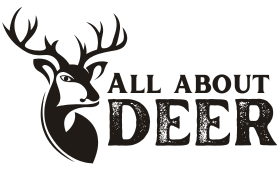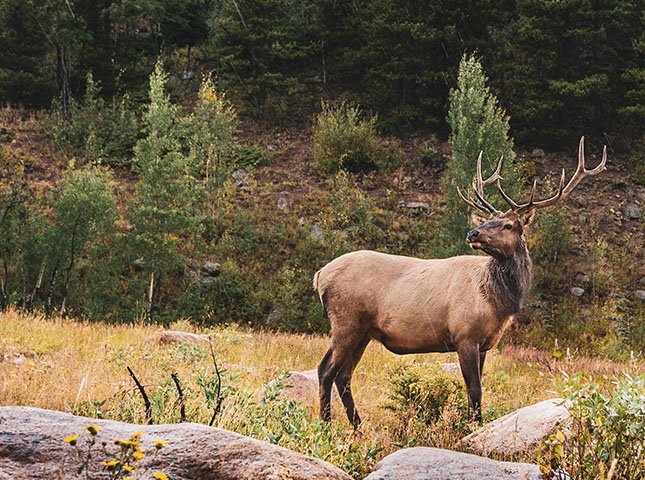Deer have a remarkable sense of smell. How far can they detect scents? Let’s investigate.
Their keen olfactory ability is vital for survival. It helps them identify dangers, find food, and communicate with others. Deer can detect scents from an incredible 300 yards away.
What makes their sense of smell so special? Their noses contain advanced olfactory receptors that can recognize different smells in the air. These receptors are more advanced than humans.
Plus, deer have a vomeronasal organ above the roof of their mouths. It boosts their scent-detection capabilities. With both their noses and this organ, they can perceive and process scents amazingly.
Table of Contents
How Far Can a Deer Smell?
A deer’s sense of smell is remarkably powerful, capable of detecting scents from great distances. These animals possess an acute sense of smell, allowing them to detect odors and potential dangers in their surroundings. This heightened sense is further supplemented by the deer’s specialized nose, which contains up to 297 million olfactory receptors, enabling them to identify even the faintest scents.
Prepare to be blown away as we delve into the hidden world of deer anatomy and the mind-boggling abilities of their olfactory system…this isn’t just your run-of-the-mill biology lesson, folks!
Deer Anatomy and Olfactory System
Deer boast a remarkable olfactory system. Their nasal cavity is packed with olfactory epithelium cells containing receptor proteins that bind to scent molecules. This arrangement of cells enables them to detect and differentiate odors in their environment.
Plus, they have a special organ called the vomeronasal (VNO), located in the roof of their mouths. When deer open their mouths slightly and curl their upper lip (known as the “flehmen response”), they’re able to pick up chemical signals emitted by other deer.
Their superior sense of smell allows them to detect scents from long distances. Even faint traces of human or predator odors can be detected by deer, allowing them to elude danger.
So, if you’re hunting or observing deer, remember to take steps to minimize your scent, like using unscented products and odor-neutralizing clothing. This will help you stay undetected!
Factors Affecting a Deer’s Sense of Smell
Factors Influencing a Deer’s Sense of Smell
A deer’s sense of smell is greatly affected by various factors, which contribute to its remarkable olfactory abilities. These factors include genetic predisposition, environmental conditions, and physiological characteristics.
- Genetic Predisposition: Deer inherit their exceptional sense of smell from their ancestors through genetic traits. The genes responsible for odor detection and processing play a crucial role in their olfactory capabilities. This genetic makeup determines the sensitivity and range of their sense of smell.
- Environmental Conditions: The environment in which deer reside significantly influences their sense of smell. Various elements such as wind direction, humidity, and temperature affect the transmission and dispersion of odors. Favorable environmental conditions enhance a deer’s ability to detect scents from considerable distances.
- Physiological Characteristics: Deer possess anatomical features that enhance their sense of smell. They have a large surface area of olfactory receptors in their nasal passages, allowing for efficient detection of odors. Additionally, their specialized nasal structure enables them to differentiate between different scent molecules and decipher complex odors.
Notably, certain other aspects remain noteworthy. Factors like age and health condition can influence a deer’s sense of smell. Younger deer generally have a more developed sense of smell compared to older ones. Similarly, a deer’s health, especially the condition of its nasal passages, can impact its olfactory abilities.
A fascinating fact is that deer possess a vomeronasal organ, which aids in detecting pheromones and scent markings left by other deer. This organ, also known as Jacobson’s organ, amplifies their ability to communicate and gather information about their surroundings.
Wind Direction
Wind direction plays a major role in a deer’s sense of smell. It determines if a scent will reach the deer’s nose. A deer’s olfactory system lets it sense even faint smells. This helps them detect predators, find food, and find mates. But, if the wind is blowing towards the deer, it is harder to identify the source of a scent. On windy days, deer may not be able to tell where a smell is coming from. Experienced hunters use this knowledge for their advantage. By positioning themselves downwind from their target, their scent won’t be detected.
Terrain and Vegetation
Terrain and vegetation are very important to a deer’s sense of smell. They can influence its olfactory capabilities.
In open grasslands, the scent particles spread quickly, making it hard for deer to detect smells. But in dense forests or hilly areas with lots of vegetation, the scents get trapped and concentrated, so deer can smell things from far away.
Plants can also affect a deer’s sense of smell. Some plants emit strong odors that can mask or overpower other smells, confusing the deer. Different plant species have odors that deer recognize as food or warning signs.
Researchers did an experiment to show how terrain and vegetation influence a deer’s smell. They put food in two places: an open field and a thick forest. The deer located the food in the forest faster, because the scent was concentrated in the dense vegetation.
Understanding how terrain and vegetation affect a deer’s sense of smell is important for wildlife management and conservation. By considering these factors, we can understand how environmental conditions impact animal behavior, helping us protect animals and their habitats.
Time of Day
In the dark night, the silence is complete. Deer’s olfaction comes to life. No people and no pollution, so these animals can smell better. This makes it easier to find food and detect danger in the dark.
Research shows that a deer’s smell changes during the day. Mornings are best, because of the dew. When the sun is high, it’s harder for deer to smell.
Hunters have used this knowledge of deer smell for centuries. They plan hunts based on when deer can most easily smell. This helps them hunt more successfully. People have been using this knowledge all around the world.
By understanding how Time of Day affects deer smell, hunters and wildlife fans can learn more about deer behavior. This is fascinating to those who love the wonders of nature.
Importance of Understanding a Deer’s Sense of Smell for Hunters
The significance of comprehending a deer’s olfactory capabilities for hunters lies in understanding how far a deer can detect scents. By understanding the range of a deer’s sense of smell, hunters can strategize their approach accordingly, ensuring their scent does not give away their presence. Effective scent control becomes imperative in order to minimize the chances of detection and increase the success rate of hunting expeditions. Additionally, knowledge of a deer’s sense of smell allows hunters to identify potential areas likely to be frequented by deer, further enhancing their hunting experience.
A pro tip to maximize success is to use scent control products and techniques to minimize human odor and prevent alerting the deer.
Reducing human scent is as challenging as convincing a teenage boy to put on deodorant, but here are some tips to try anyway.
Tips for Reducing Human Scent
- Wear scent-free clothing and use odor-neutralizing hygiene products.
- Store hunting gear in airtight containers or bags.
- Avoid smoking, strong-smelling foods, and touching vegetation while hunting.
- Wash clothes with scent-free detergent and hang to air dry.
- Use cover scents like deer urine or pine spray to mask your scent.
Wow! Did you know? Deer have 297 million olfactory receptors. This means they can detect scents easily. So it is important to minimize human odor when hunting.
Strategies for Hunting Downwind
Mastering downwind hunting requires careful planning. Here’s a guide to help you out!
- Check the wind direction. Use a tool such as a powder puff. Make sure the wind is going from your hunting spot to the deer.
- Pick an ideal spot. Hide and have a clear view of deer activity areas. Consider vegetation cover, escape routes, and access to food.
- Control your scent. Wash your hunting garments with odor-eliminating detergents. Use scent-blocking sprays on your body and gear.
- Plan your approach. Don’t disturb nearby deer with noise or scent. Use natural barriers like ridges or dense foliage.
- Move slowly and silently. Step lightly, avoid dry leaves, and tread carefully.
- Monitor continuously. Be patient and wait for the right moment to take a shot. Keep an eye on wind direction changes.
Adapt these strategies for different hunting conditions. Don’t underestimate the importance of understanding a deer’s sense of smell. Mastering downwind strategies increases your chances of success and the overall experience of being in nature’s realm. Happy hunting!
Conclusion
Deer have a remarkable sense of smell. Studies show it can reach up to half a mile! They can identify different odors, even from hundreds of yards away. Plus, they can detect pheromones. These are chemical signals between animals that communicate messages. Deer rely on this sense to stay safe and find food.
Frequently Asked Questions
Q: How far can a deer smell?
A: Deer have an exceptional sense of smell and can detect scents from incredibly long distances. On average, they can smell food, predators, or other deer from up to 300 yards away.
Q: Can a deer smell human scent?
A: Yes, deer can smell human scent. While the range can vary depending on factors such as wind direction and weather conditions, deer can typically detect human scent from around 100 to 200 yards away.
Q: Why do deer have such a strong sense of smell?
A: Deer rely heavily on their sense of smell for survival. Their strong sense of smell helps them detect predators, find potential mates, locate food sources, and communicate with other deer.
Q: How does a deer’s sense of smell compare to a dog’s?
A: A deer’s sense of smell is often compared to that of a dog, as both animals have an exceptional olfactory system. While dogs may have a more acute sense of smell overall, deer can still detect odors over much longer distances.
Q: Can deer smell food even if it is sealed in a container?
A: Yes, deer can still smell food even if it is sealed in a container. While airtight containers may reduce the scent to some extent, deer have a highly sensitive nose and can often detect even the slightest odor.
Q: Can deer smell you if you are downwind?
A: Deer are incredibly perceptive and can often smell humans even when the wind is blowing in the opposite direction (downwind). However, being downwind might slightly decrease the chances of detection as the scent disperses in a different direction.


